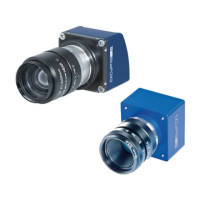18.7 Working with LUTs
There are several use cases concerning LUTs (Look-Up-Tables):
18.8 Saving data on the device
Note:
As described in Storing and restoring settings, it is also possible to save the settings as an
XML file on the host system. You can find further information about for example the XML
compatibilities of the different driver versions in the mvIMPACT Acquire SDK manuals and
the according setting classes:
https://www.matrix-vision.com/manuals/SDK_CPP/classmvIMPACT_1_1acquire_1_1FunctionInterface.html
(C++)
There are several use cases concerning device memory:
18.8.1 Creating user data entries
18.8.1.1 Basics about user data
It is possible to save arbitrary user specific data on the hardware's non-volatile memory. The
amount of possible entries depends on the length of the individual entries as well as the size of the
devices non-volatile memory reserved for storing:
mvBlueFOX,•
mvBlueFOX-M,•
mvBlueFOX-MLC,•
mvBlueFOX3, and•
mvBlueCOUGAR-X•
currently offer 512 bytes of user accessible non-volatile memory of which 12 bytes are needed to
store header information leaving 500 bytes for user specific data.
One entry will currently consume:
1 + <length_of_name (up to 255 chars)> + 2 + <length_of_data (up to 65535 bytes)> + 1 (access mode) bytes
as well as an optional:
1 + <length_of_password> bytes per entry if a password has been defined for this particular entry
It is possible to save either String or Binary data in the data property of each entry. When storing
binary data please note, that this data internally will be stored in Base64 format thus the amount of
memory required is 4/3 time the binary data size.
The UserData can be accessed and created using wxPropView (the device has to be closed). In the
section "UserData" you will find the entries and following methods:
18 Use cases
231

